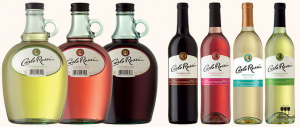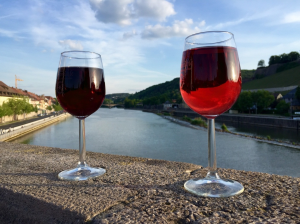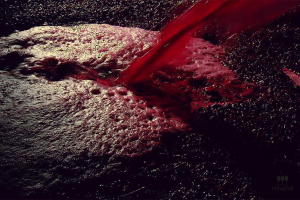GASTRONOMIC COMBINATION
 Before you comprehend the subtleties of the selection of the ideal combinations of wines and dishes, let’s touch on the topic of recommendations for choosing a wine to the table. After all, each dish has its own wine-ally, which requires serving at the right temperature.
Before you comprehend the subtleties of the selection of the ideal combinations of wines and dishes, let’s touch on the topic of recommendations for choosing a wine to the table. After all, each dish has its own wine-ally, which requires serving at the right temperature.
The best-known and most frequently used selection technique is the Merkadini technique. It is based on the principles of similarity and contrast of tastes of food and wine.
Wine and food have four basic tastes: sweet (at the tip of the tongue), sour and salty (at the sides) and bitter (at the bottom). Let us add the sensation of fat and oily here – both cover the tongue and suppress our sensory capabilities in the mouth (in the first case – partially, and in the second – almost completely).
You should also consider the natural flavors of food, which can be enhanced with the help of aromatic herbs, spices and spices.
Finally, we must not forget about taste and olfactory persistence, that is, how long the taste of food stays in the mouth after swallowing. It is important to unravel the components of the taste of food in order to understand what needs to be emphasized and what is compensated for with the help of wine.
With wine – the same story: it is necessary to unravel the constituent elements and basic characteristics. Having distinguished the dominant tastes, it is important to decide whether to emphasize the gastronomic combination or to soften these aspects.
SEARCHING FOR BEST COMBINATIONS
It is important to remember that the perfect combination is when both elements help each other, rather than dominate one another. The consistency of the wine should be proportional to the structure of the dish. Red wines are suitable for complex dishes. Strong wines of good aging perfectly complement the dishes of complex preparation (for example, cooking). But the combination of rich wines with light delicate dishes negates the pleasure of both.
COMBINATION ON CONTRAST AND LIKE
It is also noticed that the most pleasant combination is obtained when the wine expresses characteristics opposite to food. In this case, the wine should contrast or slightly muffle the dominant food.
In the case of a combination of similarity harmony is achieved by matching the tactile sensations. A vivid example is the combination of sweet dishes with sweet wines. The palate, getting used to the sweet food, begins to react more strongly to the sour than it distorts the taste of dry wines.
SOME COMBINATIONS
Asti-spumante – puddings, fruit salads, souffles, mousses.
Barbaresco (Italian red) – roast game, beef, offal, white mushrooms, truffles.
Barolo (Italian red) – stuffed game, fat juicy beef, game stew.
Beaujolais – meat appetizers, cold roasted meats of various kinds, fish in red wine sauce, mushrooms on toasts.
Bordeaux (red) – lamb, roast beef with blood.
Bordeaux (white) – grilled fish, seafood, poultry.
Burgundian (red) – always game, duck breast, truffles.
Burgundy (white) – fish in cream sauce, cheese soufflé, fried chicken.
Brunello di Montalcino – oxtail dishes, game in a pot, hard cheeses.
Cabernet Sauvignon – red meats, kidneys, sausages, lasagna, turkey, meat on coals (In Australia, people like to give kenguryatiny to it.)
Cava (Spanish sparkling) – aperitif, scrambled eggs, smoked salmon.
Chablis – white fish (for example, sole), turbot (flounder), seafood, dishes from a mixture of: fish, rice, curry, eggs).
Champagne – aperitif, oysters, smoked salmon, caviar, Chinese food.
Chardonnay – asparagus, artichokes, shrimps, seafood, poultry, dishes with peanut sauce.
Chateau-dupe-pap – dishes in a pot (lamb, venison, game), fried goose.
Chianti – spinach, cold meat, simple meat dishes, pizza, barbecue.
Gewurztraminer (dry) – savory cheese dishes, smoked salmon, pies, spicy food, onion pie.
Gewurztraminer (sweet) – Fua-gra, puddings, pates.
Merlot – beef with porter, bean stew, veal liver, grill, tuna.
Nobile di Montepulciano – fried boar or pork, fried pigeon or quail.
Muscat (dry) – chicken with grapes, avocado salad.
Muscat (sweet) – puddings, pates, ice cream.
Pinogrigio (dry) – pork with juniper, ravioli with mushrooms.
Rioja – fried lamb, game, mushrooms, chicken barbecue.
Sancerre (white) – trout, sashimi, avocado mousse, goat cheese.
Sancerre (red) – salmon, mullet (red).
Riesling (dry) – Chinese style, avocado salad, duck goose, wild boar.
Riesling (sweet) – Fua-gra, puddings.
Sauternes – Fua-gra, puddings, caramel, blue cheeses.
Sauvignon Blanc – Thai food, seafood salads, clams, tomatoes.
Zinfandel (California) – game, spicy dishes, turkey, ratatouille, Italian appetizers, anchovies, dark chocolate.
GENERAL RULES FOR COMBINING WINE AND CHEESE
Solid – red, tannic wines. South of France, Cabernet Sauvignon from the New World.
Soft, creamy cheeses (Camembert) – white, high-acid wines. The sour the wine, the sour the cheese. Ideally combined representatives of some regions.
Cheese soufflé – aromatic white and red wines.
Cheese with blue mold (Roquefort, Gorgonzola) – Sauternes, Ricotto, Port Wine, Tokay.
Goat cheese – Sauvignon Blanc, PuiFume, Sancerre, Chardonnay




